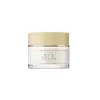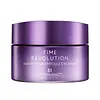What's inside
What's inside
 Key Ingredients
Key Ingredients

 Benefits
Benefits

 Concerns
Concerns

 Ingredients Side-by-side
Ingredients Side-by-side

Oryza Sativa Bran Water
MaskingWater
Skin ConditioningGlycerin
HumectantButylene Glycol
HumectantCetyl Ethylhexanoate
EmollientPentaerythrityl Tetraethylhexanoate
EmollientHydrogenated Polyisobutene
EmollientSynthetic Beeswax
Emulsion StabilisingButyrospermum Parkii Butter
Skin ConditioningPolyglyceryl-3 Methylglucose Distearate
EmulsifyingVinyldimethicone
Pentylene Glycol
Skin Conditioning1,2-Hexanediol
Skin ConditioningBehenyl Alcohol
EmollientGlyceryl Stearate
EmollientAmmonium Acryloyldimethyltaurate/Vp Copolymer
Bisabolol
MaskingCetearyl Olivate
Panthenol
Skin ConditioningSorbitan Olivate
EmulsifyingCaprylyl Glycol
EmollientEthylhexylglycerin
Skin ConditioningXanthan Gum
EmulsifyingAdenosine
Skin ConditioningTrisodium Ethylenediamine Disuccinate
Sodium Hyaluronate
HumectantCeramide NP
Skin ConditioningHydrolyzed Hyaluronic Acid
HumectantOryza Sativa Bran Oil
EmollientTocopherol
AntioxidantPhytosphingosine
Skin ConditioningCaprylic/Capric Triglyceride
MaskingHydrogenated Lecithin
EmulsifyingOryza Sativa Bran Water, Water, Glycerin, Butylene Glycol, Cetyl Ethylhexanoate, Pentaerythrityl Tetraethylhexanoate, Hydrogenated Polyisobutene, Synthetic Beeswax, Butyrospermum Parkii Butter, Polyglyceryl-3 Methylglucose Distearate, Vinyldimethicone, Pentylene Glycol, 1,2-Hexanediol, Behenyl Alcohol, Glyceryl Stearate, Ammonium Acryloyldimethyltaurate/Vp Copolymer, Bisabolol, Cetearyl Olivate, Panthenol, Sorbitan Olivate, Caprylyl Glycol, Ethylhexylglycerin, Xanthan Gum, Adenosine, Trisodium Ethylenediamine Disuccinate, Sodium Hyaluronate, Ceramide NP, Hydrolyzed Hyaluronic Acid, Oryza Sativa Bran Oil, Tocopherol, Phytosphingosine, Caprylic/Capric Triglyceride, Hydrogenated Lecithin
Bifida Ferment Lysate
Skin ConditioningGlycerin
HumectantMethylpropanediol
SolventCyclohexasiloxane
EmollientHydrogenated Polyisobutene
EmollientCaprylic/Capric Triglyceride
MaskingTriethylhexanoin
MaskingNiacinamide
SmoothingCetearyl Alcohol
EmollientWater
Skin ConditioningDimethicone
EmollientStearyl Alcohol
EmollientTrehalose
HumectantCentella Asiatica Extract
CleansingFicus Carica Fruit Extract
HumectantDioscorea Japonica Root Extract
Skin ConditioningOryza Sativa Extract
AbsorbentPhellodendron Amurense Bark Extract
Skin ConditioningLactobacillus/Punica Granatum Fruit Ferment Extract
Skin ConditioningLactobacillus/Soybean Ferment Extract
Skin ConditioningMonascus Extract
Skin ConditioningSolanum Melongena Fruit Extract
Skin ConditioningDaucus Carota Sativa Root Extract
Skin ConditioningVaccinium Angustifolium Fruit Extract
Skin ProtectingBeta Vulgaris Root Extract
Skin ConditioningBrassica Oleracea Capitata Leaf Extract
Skin ConditioningCitrus Aurantium Bergamia Fruit Oil
MaskingPelargonium Graveolens Flower Oil
MaskingHydrogenated Lecithin
EmulsifyingCamellia Sinensis Seed Oil
HumectantCamellia Japonica Seed Oil
EmollientArgania Spinosa Kernel Oil
EmollientOlea Europaea Fruit Oil
MaskingMacadamia Integrifolia Seed Oil
Skin ConditioningHelianthus Annuus Seed Oil
EmollientSimmondsia Chinensis Seed Oil
EmollientLavandula Angustifolia Oil
MaskingCitrus Aurantium Dulcis Peel Oil
MaskingAnthemis Nobilis Flower Oil
MaskingSantalum Album Oil
MaskingBeeswax
Emulsion StabilisingCetyl Alcohol
EmollientCetearyl Glucoside
EmulsifyingVinyldimethicone
Polyglyceryl-2 Triisostearate
EmulsifyingCetearyl Olivate
Sorbitan Olivate
EmulsifyingGlyceryl Stearate
EmollientPalmitic Acid
EmollientStearic Acid
CleansingAmmonium Acryloyldimethyltaurate/Vp Copolymer
Glycosyl Trehalose
Emulsion StabilisingXanthan Gum
EmulsifyingHydrogenated Starch Hydrolysate
HumectantAdenosine
Skin ConditioningRaffinose
Skin ConditioningGlyceryl Polymethacrylate
Dextrin
AbsorbentTheobroma Cacao Shell Powder
AbrasiveLactobacillus Ferment
Skin ConditioningLactococcus Ferment Lysate
Skin ConditioningLactobacillus/Acerola Cherry Ferment
Skin ProtectingLactobacillus Ferment Lysate
Skin ConditioningLactococcus Ferment
Skin ConditioningLeuconostoc/Radish Root Ferment Filtrate
AntimicrobialDisodium EDTA
Lecithin
EmollientGlucose
HumectantPolyquaternium-51
Skin ConditioningCeramide NP
Skin ConditioningMyristic Acid
CleansingSucrose Distearate
EmollientDipropylene Glycol
HumectantBiosaccharide Gum-1
HumectantSaccharomyces Ferment
Skin ConditioningPhytosteryl/Isostearyl/Cetyl/Stearyl/Behenyl Dimer Dilinoleate
Skin ConditioningCeramide AP
Skin Conditioning1,2-Hexanediol
Skin ConditioningHydroxyacetophenone
AntioxidantEthylhexylglycerin
Skin ConditioningLimonene
PerfumingCitronellol
PerfumingGeraniol
PerfumingLinalool
PerfumingBifida Ferment Lysate, Glycerin, Methylpropanediol, Cyclohexasiloxane, Hydrogenated Polyisobutene, Caprylic/Capric Triglyceride, Triethylhexanoin, Niacinamide, Cetearyl Alcohol, Water, Dimethicone, Stearyl Alcohol, Trehalose, Centella Asiatica Extract, Ficus Carica Fruit Extract, Dioscorea Japonica Root Extract, Oryza Sativa Extract, Phellodendron Amurense Bark Extract, Lactobacillus/Punica Granatum Fruit Ferment Extract, Lactobacillus/Soybean Ferment Extract, Monascus Extract, Solanum Melongena Fruit Extract, Daucus Carota Sativa Root Extract, Vaccinium Angustifolium Fruit Extract, Beta Vulgaris Root Extract, Brassica Oleracea Capitata Leaf Extract, Citrus Aurantium Bergamia Fruit Oil, Pelargonium Graveolens Flower Oil, Hydrogenated Lecithin, Camellia Sinensis Seed Oil, Camellia Japonica Seed Oil, Argania Spinosa Kernel Oil, Olea Europaea Fruit Oil, Macadamia Integrifolia Seed Oil, Helianthus Annuus Seed Oil, Simmondsia Chinensis Seed Oil, Lavandula Angustifolia Oil, Citrus Aurantium Dulcis Peel Oil, Anthemis Nobilis Flower Oil, Santalum Album Oil, Beeswax, Cetyl Alcohol, Cetearyl Glucoside, Vinyldimethicone, Polyglyceryl-2 Triisostearate, Cetearyl Olivate, Sorbitan Olivate, Glyceryl Stearate, Palmitic Acid, Stearic Acid, Ammonium Acryloyldimethyltaurate/Vp Copolymer, Glycosyl Trehalose, Xanthan Gum, Hydrogenated Starch Hydrolysate, Adenosine, Raffinose, Glyceryl Polymethacrylate, Dextrin, Theobroma Cacao Shell Powder, Lactobacillus Ferment, Lactococcus Ferment Lysate, Lactobacillus/Acerola Cherry Ferment, Lactobacillus Ferment Lysate, Lactococcus Ferment, Leuconostoc/Radish Root Ferment Filtrate, Disodium EDTA, Lecithin, Glucose, Polyquaternium-51, Ceramide NP, Myristic Acid, Sucrose Distearate, Dipropylene Glycol, Biosaccharide Gum-1, Saccharomyces Ferment, Phytosteryl/Isostearyl/Cetyl/Stearyl/Behenyl Dimer Dilinoleate, Ceramide AP, 1,2-Hexanediol, Hydroxyacetophenone, Ethylhexylglycerin, Limonene, Citronellol, Geraniol, Linalool
 Reviews
Reviews

Ingredients Explained
These ingredients are found in both products.
Ingredients higher up in an ingredient list are typically present in a larger amount.
1,2-Hexanediol is a synthetic liquid and another multi-functional powerhouse.
It is a:
- Humectant, drawing moisture into the skin
- Emollient, helping to soften skin
- Solvent, dispersing and stabilizing formulas
- Preservative booster, enhancing the antimicrobial activity of other preservatives
Adenosine is in every living organism. It is one of four components in nucleic acids that helps store our DNA.
Adenosine has many benefits when used. These benefits include hydrating the skin, smoothing skin, and reducing wrinkles. Once applied, adenosine increases collagen production. It also helps with improving firmness and tissue repair.
Studies have found adenosine may also help with wound healing.
In skincare products, Adenosine is usually derived from yeast.
Learn more about AdenosineAmmonium Acryloyldimethyltaurate/Vp Copolymer (let's call it AAVC for short) is a synthetically created polymer. It's used as a film-forming agent and used to thicken the consistency of products.
AAVC is able to increase the consistency and viscosity of products due to its large molecule size. It also prevents ingredients from separating.
This ingredient is an emollient, solvent, and texture enhancer. It is considered a skin-softener by helping the skin prevent moisture loss.
It helps thicken a product's formula and makes it easier to spread by dissolving clumping compounds.
Caprylic Triglyceride is made by combining glycerin with coconut oil, forming a clear liquid.
While there is an assumption Caprylic Triglyceride can clog pores due to it being derived from coconut oil, there is no research supporting this.
Learn more about Caprylic/Capric TriglycerideCeramide NP is a type of ceramide and formally known as ceramide 3.
Ceramides are intercellular lipids naturally found in our skin that bonds dead skin cells together to create a barrier. They are known for their ability to hold water and thus are a great ingredient for dry skin.
Ceramides are an important building block for our skin barrier. A stronger barrier helps the skin look more firm and hydrated. By bolstering the skin ceramides act as a barrier against irritating ingredients. This can help with inflammation as well.
If you would like to eat ceramides, sweet potatoes contain a small amount.
Read more about other common types of ceramides here:
Ceramide AP
Ceramide EOP
Cetearyl Olivate is an emulsifier and texture enhancer. It is derived from the fatty acids of olive oil and Cetearyl alcohol, and is biodegradable.
As an emulsifier, it is used to prevent oils and waters from separating. It can also
Manufacturers use the name Olivem 1000. This ingredient has been found to preserve the natural microbiome of skin. Having a healthy microbiome helps keep our skin healthy and protects against harmful bacteria. This ingredient is grouped with Sorbitan Olivate under the name Olivem 1000.
Learn more about Cetearyl OlivateEthylhexylglycerin (we can't pronounce this either) is commonly used as a preservative and skin softener. It is derived from glyceryl.
You might see Ethylhexylglycerin often paired with other preservatives such as phenoxyethanol. Ethylhexylglycerin has been found to increase the effectiveness of these other preservatives.
Glycerin is already naturally found in your skin. It helps moisturize and protect your skin.
A study from 2016 found glycerin to be more effective as a humectant than AHAs and hyaluronic acid.
As a humectant, it helps the skin stay hydrated by pulling moisture to your skin. The low molecular weight of glycerin allows it to pull moisture into the deeper layers of your skin.
Hydrated skin improves your skin barrier; Your skin barrier helps protect against irritants and bacteria.
Glycerin has also been found to have antimicrobial and antiviral properties. Due to these properties, glycerin is often used in wound and burn treatments.
In cosmetics, glycerin is usually derived from plants such as soybean or palm. However, it can also be sourced from animals, such as tallow or animal fat.
This ingredient is organic, colorless, odorless, and non-toxic.
Glycerin is the name for this ingredient in American English. British English uses Glycerol/Glycerine.
Learn more about GlycerinGlyceryl Stearate is a mix of glycerin and stearic acid.
It is used to stabilize the mixing of water and oil ingredients. By preventing these ingredients from separating, it can help elongate shelf life. It can also help thicken the product's texture.
As an emollient, it helps soften skin and supports barrier-replenishing ingredients.
In cosmetics, Glyceryl Stearate is often made from vegetable oils or synthetically produced.
This ingredient may not be fungal-acne safe
Fun fact: The human body also creates Glyceryl Stearate naturally.
Learn more about Glyceryl StearateHydrogenated Lecithin is created from the hydrogenation of lecithin (a group of phospholipids). Hydrogenation is a chemical reaction between hydrogen and another element.
This ingredient is an emollient and emulsifier. As an emollient, it helps soften skin by trapping moisture within. As an emulsifier, it prevents oil and water ingredients from separating.
Hydrogenated Polyisobutene is a synthetic polymer. Polymers are compounds with high molecular weight. Hydrogenated Polyisobutene is an emollient and texture enhancer.
In one study, Hydrogenated Polyisobutene showed better skin hydration levels than Caprylic/Capric Triglyceride. As an emollient, it helps keep your skin soft and hydrated by trapping moisture in.
Hydrogenated Polyisobutene is often used as a mineral oil replacement.
Learn more about Hydrogenated PolyisobuteneSorbitan Olivate is created from the fatty acids in olive oil and sorbitol.
This ingredient is an oil in water emulsifier. It helps stabilize a product by preventing oils and waters from separating. Sorbitan Olivate also helps hydrate the skin.
Manufacturers sell sorbitan olivate under the name OliveM 1000. OliveM 1000 a multifunctional ingredient. It is self-emulsifying. According to a manufacturer, OliveM 1000 does not disrupt natural skin biome.
Due to its olive oil base, this ingredient may not be fungal-acne safe.
Learn more about Sorbitan OlivateVinyldimethicone is a type of silicone.
Water. It's the most common cosmetic ingredient of all. You'll usually see it at the top of ingredient lists, meaning that it makes up the largest part of the product.
So why is it so popular? Water most often acts as a solvent - this means that it helps dissolve other ingredients into the formulation.
You'll also recognize water as that liquid we all need to stay alive. If you see this, drink a glass of water. Stay hydrated!
Learn more about WaterXanthan gum is used as a stabilizer and thickener within cosmetic products. It helps give products a sticky, thick feeling - preventing them from being too runny.
On the technical side of things, xanthan gum is a polysaccharide - a combination consisting of multiple sugar molecules bonded together.
Xanthan gum is a pretty common and great ingredient. It is a natural, non-toxic, non-irritating ingredient that is also commonly used in food products.
Learn more about Xanthan Gum